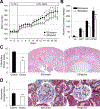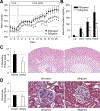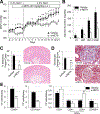Parental Dietary Protein Source and the Role of CMKLR1 in Determining the Severity of Dahl Salt-Sensitive Hypertension
- PMID: 30595125
- PMCID: PMC6326874
- DOI: 10.1161/HYPERTENSIONAHA.118.11994
Parental Dietary Protein Source and the Role of CMKLR1 in Determining the Severity of Dahl Salt-Sensitive Hypertension
Abstract
Studies from our laboratory have revealed an important role for the maternal diet and the dietary protein source in the development of hypertension and renal injury in Dahl salt-sensitive (SS) rats. The current study sought to compare salt-induced hypertension, renal damage, and immune cell infiltration in the offspring of breeders fed either a casein- or gluten-based diet, with the hypothesis that offspring from gluten-fed breeders would fail to develop these SS phenotypes. When fed identical diets post-weaning, the F1 generation gluten offspring demonstrated lower mean arterial pressure (149.1±3.1 versus 162.5±5.8 mm Hg), albuminuria (166.2±34.6 versus 250.9±27.8 mg/day), and outer medullary protein casting (7.4±0.8% versus 13.1±1.3%) in response to high salt compared with the casein offspring (n=9-11). The gluten offspring also had fewer CD45+ leukocytes, CD11b/c+ monocytes/macrophages, CD3+ T cells, and CD45R+ B cells infiltrating the kidney. Analysis of the F2 generation gluten offspring also exhibited lower mean arterial pressure and renal damage compared with rats born from casein breeders (n=7-9), with no difference in renal immune cell infiltration. CMKLR1-receptor for the novel prohypertensive adipokine chemerin-was found via polymerase chain reaction array to be significantly upregulated (2.99-fold) in renal T cells isolated from F2 offspring of casein-fed versus gluten-fed parents. Furthermore, CMKLR1 inhibition via α-NETA (2-[α-naphthoyl] ethyltrimethylammonium iodide) treatment significantly attenuated renal immune cell infiltration, hypertension, and renal damage in SS rats fed high salt. Together, these data demonstrate the influence of the parental diet in determining the salt-induced hypertension, renal damage, and inflammatory phenotype of the offspring.
Keywords: T lymphocytes; animals; dietary proteins; kidney; rats.
Figures





References
-
- Shimokawa T, Moriuchi A, Hori T, Saito M, Naito Y, Kabasawa H, Nagae Y, Matsubara M, Okuyama H. Effect of dietary alpha-linolenate/linoleate balance on mean survival time, incidence of stroke and blood pressure of spontaneously hypertensive rats. Life Sci 1988;43:2067–2075 - PubMed
-
- Zhang HY, Reddy S, Kotchen TA. A high sucrose, high linoleic acid diet potentiates hypertension in the dahl salt sensitive rat. Am J Hypertens 1999;12:183–187 - PubMed
-
- Mori Y, Murakawa Y, Yokoyama J, Tajima N, Ikeda Y, Nobukata H, Ishikawa T, Shibutani Y. Effect of highly purified eicosapentaenoic acid ethyl ester on insulin resistance and hypertension in dahl salt-sensitive rats. Metabolism 1999;48:1089–1095 - PubMed
Publication types
MeSH terms
Substances
Grants and funding
LinkOut - more resources
Full Text Sources
Medical
Research Materials
Miscellaneous

